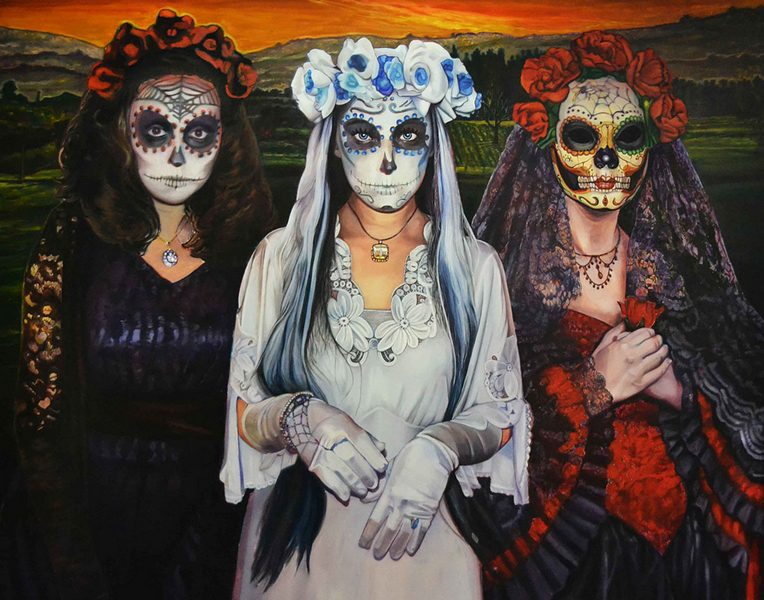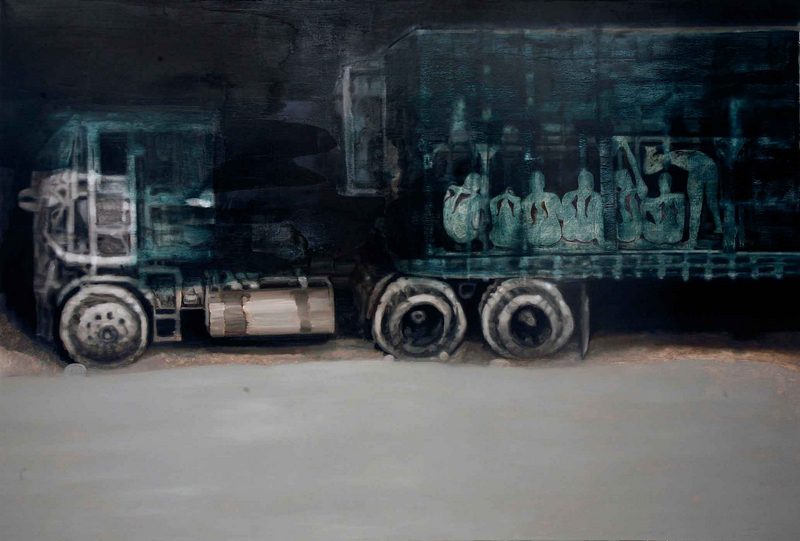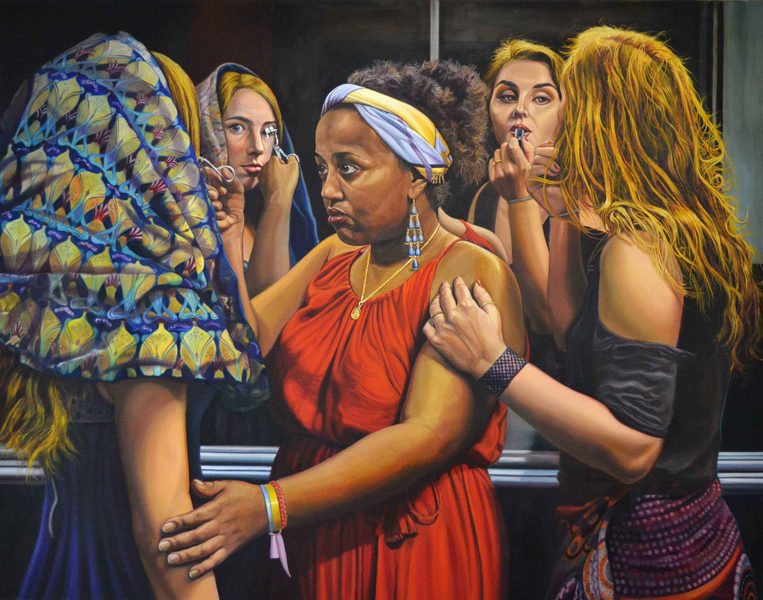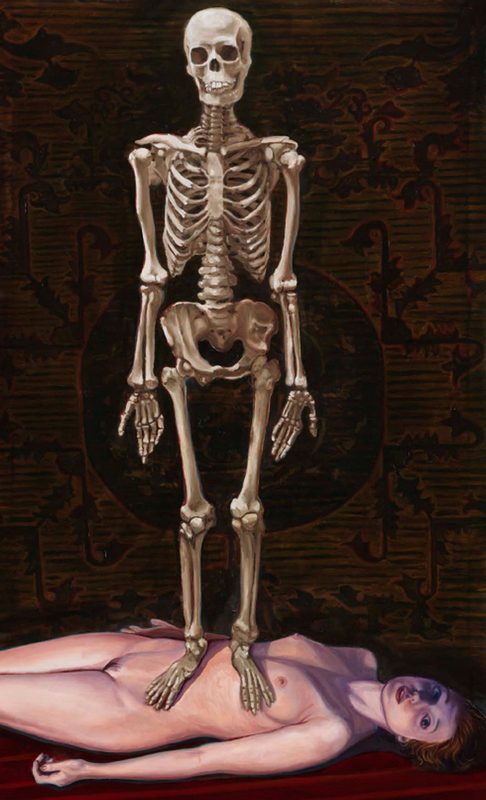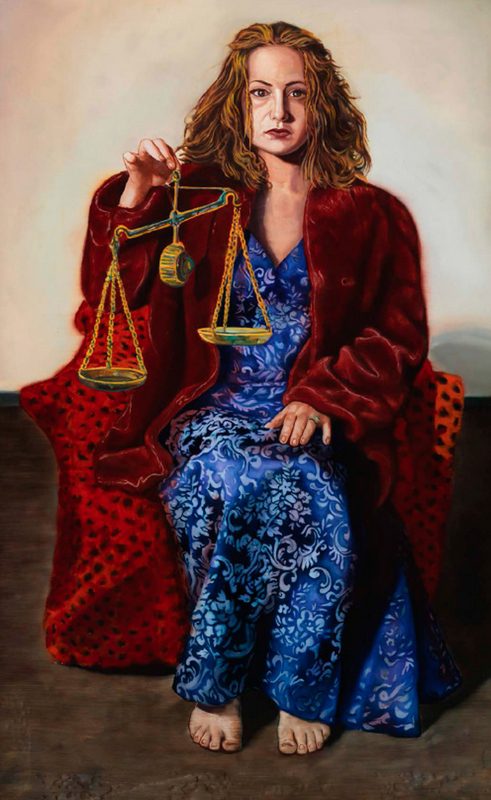INTERVIEW: Dimitris Tzamouranis
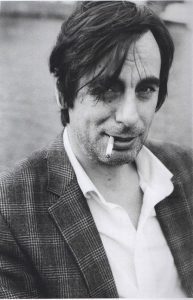 The years that I know Dimitri Tzamouransi, since we belong in the same generation, are as much as we are both in the art world, from his first series of artworks with the poses and the photos which had presented 20 years ago, until today that his painting at the Zina Athanasiadou Gallery, is an exhibition of museum standards and surprised us pleasantly. ‘’A day for Life, A day for Death’’, life and death, the present and an uncertain future, with a very sarcastic style and delicate sensitivity, reflected on canvas and create a new visual environment, which seems to springs from theatrical scenes of classical works or works of Kahlo and Rubens, but with the view of a contemporary artist who makes an international career, since he lives and works in Berlin since 1990, having exhibited in Museums and Galleries in Europe. The last two years he had retrospectives of his work at Kunsthalle Osnabruck in Germany, at the Miro Gallery in Prague and at the Frissiras Museum in Athens, and recently introduced his new painting job in Haas Gallery in Zurich, Switzerland.
The years that I know Dimitri Tzamouransi, since we belong in the same generation, are as much as we are both in the art world, from his first series of artworks with the poses and the photos which had presented 20 years ago, until today that his painting at the Zina Athanasiadou Gallery, is an exhibition of museum standards and surprised us pleasantly. ‘’A day for Life, A day for Death’’, life and death, the present and an uncertain future, with a very sarcastic style and delicate sensitivity, reflected on canvas and create a new visual environment, which seems to springs from theatrical scenes of classical works or works of Kahlo and Rubens, but with the view of a contemporary artist who makes an international career, since he lives and works in Berlin since 1990, having exhibited in Museums and Galleries in Europe. The last two years he had retrospectives of his work at Kunsthalle Osnabruck in Germany, at the Miro Gallery in Prague and at the Frissiras Museum in Athens, and recently introduced his new painting job in Haas Gallery in Zurich, Switzerland.
By Efi Michalarou
Photo: Zina Athanasiadou Gallery Archive
Mr. Tzamouranis, on the occasion of your new series of works, which is painting, as we know your work since you started in art, what was that which pushed you over the past years to switch in painting?
From the beginning of my art education with my father, which is a painter and my studies in Thessaloniki-Berlin until today, my visual language is based on painting. This one, someone might realize it, in retrospectives carried out in Prague, in the city of Osnabrück in Germany and at Frissiras Museum in Athens. The period 1995-2004, I experimented with the photography and video in the effort, to renew my eyes and actually incorporated elements of the new technologies in my paintings. For example the relation of movement-immobility in a composition. The evolution of technology, clearly affects the painters. Let us not forget the influence brought by the invention of the camera obscura to artists such as Caravaggio or Vermeer. Of course, Vermeer never claimed that the machine used as a visual aid, is the painting. In the thirst for the “new” in the ’90s, asked me to participate in some exhibitions, presenting my concerns in photography and video. At that time, I had no problem, since I saw it as an opportunity to show the process of my work, but also the image file that I used at that time for my paintings. At a meeting in Berlin before about 12-13 years with the Director of the National Museum of Contemporary Art, Mrs. Anna Kafetsi I found myself in a difficult position. She asked me to send her my videos that I used as archive. She could not understand that I am Painter and my work are my paintings. Therefore, I decided that I should make clear my identity as an artist. The result is that my paintings are included in about 50 collections in Europe, but there is not one, in the collection of the National Museum of Contemporary Art in Greece!
In the artworks presented at the Gallery Zina Athanassiadou in your solo exhibition entitled: “A day for Life, a day for Death”, we discern elements of pure painting, with influences from great artists. Do you believe these days, with the flood of new media, that, more and more artists use them, there is a reinterpretation in a classical method such as painting?
I will try to respond by making a short review of the art history of in relation to the political and economic conditions of the last 100 years in Europe, because I believe that they are connected. The First World War, the last century marks the violent end to the evolution of the ideas of Renaissance and Enlightenment in Europe. It is the moment of the destruction, of a Bourgeois culture that was nurtured from the ideas of Enlightenment and Democracy. In my personal opinion, this disaster in Europe is the beginning of the so-called Financial Neoliberalism. The misery that followed in the interwar period was expressed in art by the culture of protest of the Proletariat, the “Modernism” as is characterized today. As I mentioned above, the Bourgeois economy and culture was dissolved by the Plutocracy. The result is known: Rise of Fascism in Europe and victimization of Modernism, which was characterized as “cursed Art” (entartete Kunst) and enforcement of Nazi ideology in all the forms of art. The period after the second destruction of Europe, dominated by the cold war and the impact of two ideologies. In Eastern Europe (Soviet Union), the production of cultural goods, was under the control of the Communist State-Dictatorship. In the West, we have the arbitrary adoption of Modernism, in the name of freedom of the artist. This is paradox since we now know that this has been a political decision taken by the CIA and the “Congress for cultural Freedom” established 1949 in Paris, with branches in 35 countries (Frances Stonor Saunders: «Who Paid the Piper”, New Press Publications, New York). It was a frivolous political decision and was shot down by the “Holy Beast” of Modernism, Picasso, when in 1950 Stalin gave him the Peace Award of the Soviet Union. After this shock, Picasso characterized as communist and enemy of freedom. Modernism transformed into Postmodernism. The movements succeeded each other with frantic rhythms: Abstract Expressionism, Fluxus, Arte Povera, Pop art, Conceptual Art, Performance Art, and so on. The artists were engaged in the name of freedom and Avant Guarde, within the limits of psychopathy, completely cut off from any political and social dialogue, claiming that the problem is cultural. These questions remain: From what to be released? How free is the artistic production when the main movements of the era were supported by a secret organization? After 1989 and the fall of the Berlin Wall, the masks dropped and my generation was confronted with the harsh new reality of financial neoliberalism. In this context, the artists must be flexible and to transform themselves into the role of manager, making suggestions for future «Projects». Ideally, the artist finds the money from private banks and corporations (sponsoring). In the worst scenario, the artist blackmails politically the state institutions, to borrow from private banks and pay him to accomplish the future Project in the name of Avant-garde, let us say a hole in the desert of Sahara, value of the project 1,000,000… On your question if there is a redefinition at a classical method such as painting, I cannot respond positively or negatively, it is not my role. In Berlin where I live, I can say that there are many good painters, most of them very young that survive of what they produce, because the painting has a nominal value- actual production. The same conclusion I did in the art scene of Athens in recent years. The Classical education is the tool of the artists. I do not believe that we have cultural problem of communication. The problem was and is purely political-economical.
However, we discern a relevance and an artistic affinity with the photography, you used in the past, since the way you handle and present your issues, is photographic, with visual compositions and an iconography that refers to the theater.
We live in a multifaceted age and technology has a direct impact on our communication, either with a positive or with a negative way. Of course, photography as the video have influenced my gaze as a painter. The experience of painting is multi-collectible. Conceptually, the image composition may be structured in the brain, but must be done physical object. The body must to defer and to cope through technique, to embody the idea. I think that this teaching, where the concept-idea, is translated by menial operation, in artistic language differentiateσ painting from photo or video. In a mechanical reproduction, we have the Imprinting of nature. In a well-made painting, we have transcendence.
How developed this series of works where life and death are celebrated and meet in a red thin line… as well as the tarot cards that represent the agony of the human for the future?
Usually with my models, I have a friendly relationship or are from my immediate family context. Maybe because I love the intimacy with the persons I paint. The physiognomy of a family member, can make me look back in the history of art and to recognize it again in a painting of Renaissance. In addition, one particular scene, which evolves randomly and is stored as personal experience, can give birth to the idea of the next artwork. One afternoon several months ago, my daughter Electra, met her friends in my studio, to a masquerade for a party, who were invited with masks. The result was impressive; it was as if I was observing a painting of Frida Kahlo. This was the motivation to work on one series of works. The result was two large paintings: One shows three girls looking at the mirror and put on cosmetics, an everyday practice that is contrary to the second artwork, three girls who wear the masks of death, which has inspired the work of Frida Kahlo. Through this confrontation (life-death) comes the title of the exhibition in Zina Athanasiadou Gallery. The tarot cards are a psychological game and the patterns represent primitive symbolisms. For example, the pattern of Death: symbolizes the end of a situation, but also a new beginning. These images, their origins are lost in the labyrinth of time, have been engraved in human consciousness and remain timeless. Function as catharsis. You do not need an explanatory text to understand them, nor particularly technological means to connect emotionally with them… The art is inseparable from human nature. This our creative side, reminding us to follow the thread of Ariadne, to get out of the nightmarish labyrinth of the oppression of fear for the upcoming certain death.
We notice that you use different sizes, something unusual, with three main large artworks that are different from each other and a series of smaller, from what necessarily arises that?
The true painting is based on the human scale. I try to respond to this principle and the choice of size is in proportion to the image that I want to paint.
How did you decide to integrate in this series the “Life Transport”, an artwork that particularly we stood out for many reasons, what does it mean for you?
“Life Transport”, painted in 2008 and depicts a truck, immobilized at a border inspection post. Stylistically it is painted like having been scanned to reveal its load. Human bodies are stacked in a death hug with the metal offal of the vehicle. The year 2008 was a significant year. The year of the so-called “financial crisis” in the USA, which developed into global crisis. Already at that time had started the discussion about immigration, which nowadays has taken tragic dimensions. The political treatment in Europe is made in a technocratic way that I personally find it inhuman! The concentration camps have to do with fascist ideas of the past. They have no place in a modern democratic society.
If you do not lived in Berlin for so many years do you think you would do these works? Do you have influenced by the visual surroundings and the way Berlin has evolved in recent years into a Metropolitan Center?
I believe that once someone is born in a place, there are dependencies and experiences that is not possible to override. I grew up in Kalamata, my grandfather from my mother’s side was a decorator-iconographer, my father is a painter. My first experiences with art, in my youth, was with the Byzantine art, as I had direct access to the churches of the region, but also from the relationship with my grandfather. In my father’s library, there were books for painters of the Renaissance and Modernism. Also often I was visiting the Municipal Gallery of Kalamata that on 70s, often were held exhibitions, mostly by local artists. At the School of Fine Arts of Thessaloniki, my teacher Vangelis Dimitreas often mentioned the contemporary movements and artists. Encouraged us to travel in European cities to see painting and indeed several times with my fellow students visited Paris, Venice, Amsterdam and Kassel. Later in the School of Fine Arts in Berlin, I began experimenting with new media, partly incorporated them in my painting. With this brief biographical summary, I want to tell you that this issue is complex. Over the years, artists shape their aesthetic ideology connective. The locality is a given, but variable. The artist can change, but the characteristic stigma cannot be eliminated.
Right now you are making international career, do you think it would be possible to happen something similar in Greece? Is it important for an artist to be in the center of development, to build an international career?
I cannot know. If I lived in Greece, I would have another CV, I do not know if it would be better or worse. You can do Painting everywhere. Our societies are not characterized by a lasting social peace and the international context that might be the desired for an artist is variable, depending on the socio-historical developments. Currently personally, I cannot see an art center. In N. York and London, the auction houses, are responsible for the handling of the art trade and the involvement of the “Scene” which is if in the next auction Pollock will exceed 200 million. The center of East Berlin that offered a freshness through the Galleries and the alternative spaces in the decades of the ‘90s and ‘00s now is full of restaurants for tourists and fashion boutiques. Paradoxically I remain optimistic and I believe that Europe will get rid of the financial tyranny of neoliberalism that has plagues their peoples. I believe in a contemporary “Renaissance”, where there will be not only one center, but dozens with common goals and visions based on our shared cultural-humanitarian roots!
First Publication: www.dreamideamachine.com
© Interview – Efi Michalarou
Info: “A day for Life, a day for Death”, Zina Athanassiadou Gallery, P.P. Germanou 5, Thessaloniki, Duration: 23/1-1/2/15, Days & Hours: Mon, Wed, Sat: 10:30-14:00 Tue, Thu, Fri: 10:30-14:00 & 17:3030-21:00, www.zinaathanassiadou.com
